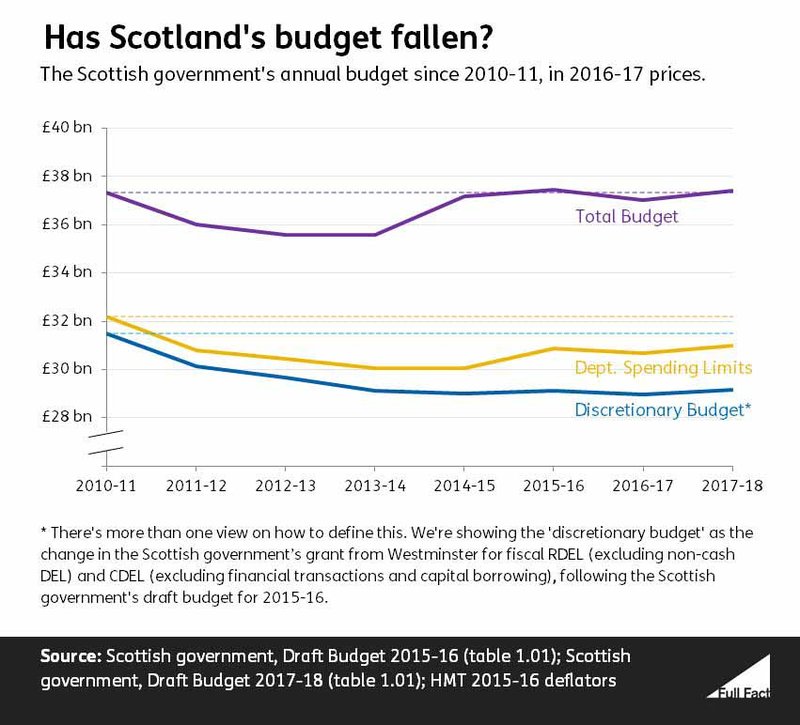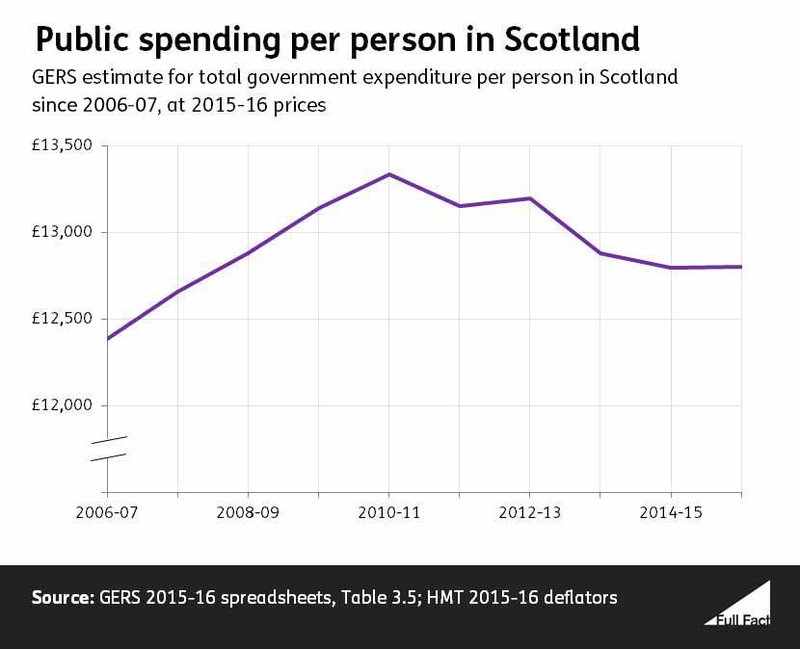BBC Question Time, factchecked
Join 72,953 people who trust us to check the facts
Sign up to get weekly updates on politics, immigration, health and more.
Subscribe to weekly email newsletters from Full Fact for updates on politics, immigration, health and more. Our fact checks are free to read but not to produce, so you will also get occasional emails about fundraising and other ways you can help. You can unsubscribe at any time. For more information about how we use your data see our Privacy Policy.
“It is absolutely clear that the people of Scotland do not want a second [independence] referendum.”
David Mundell MP, 16 February 2017
Recent polls suggest people in Scotland don’t want a second referendum, on balance, although this wasn’t the case just after the UK voted to leave the EU in June last year.
A poll just after the EU referendum found that 47% of people thought there should be another referendum on Scottish independence and 42% thought there shouldn’t be. The remaining 11% said they didn’t know. Another poll found 40% didn’t think there should be another referendum in the next few years, while the remaining 60% were split over whether there should be a referendum either before or after the UK negotiates to leave the EU.
Since then, support seems to have dropped off slightly. Several polls towards the end of last year showed a majority of Scots against having a second referendum. Meanwhile a poll just last month found that 51% of people asked didn’t want another Scottish independence referendum in the next few years. Another 27% said it should be before the UK negotiates to leave the EU in two years and the other 21% said that it should be in two years once the negotiations are complete.
The problem with comparing all these polls is that they don’t ask exactly the same question. For example people might answer questions differently if they’re given different options, such as whether there should be a referendum but not until a few years have passed. This means it's difficult to get a consistent picture of how people’s views on another Scottish independence referendum are changing, or not.
Polling expert, Professor John Curtice, has said that there seems to be “limited enthusiasm” for another independence referendum in Scotland. He has also said that people’s view on whether there should be another referendum “largely reflect[s] people’s preferences on the question of independence in the first place”.
This is something we do have more consistent information on. When asked how they would vote if there was another referendum tomorrow people’s answers showed a similar pattern of increased support after the Brexit result, followed by a fall since then. The most recent polls have found just over 40% of people in favour of independence.
There is “insufficient evidence to draw the conclusion that the disagreement over Brexit between the UK and the Scottish governments has altered the balance of opinion on independence”, according to Professor Curtice.
“If you are a bright child living in a poorer area in Scotland, you are two years behind the same child living in a more affluent area.”
David Mundell, 16 February 2017
This more or less reflects the findings of a recent study by the Sutton Trust, which the Scotland Office confirmed is the source of the claim.
It’s actually referring to the family economic background of the children, rather than the area they live in, and it specifically relates to 15 year olds. Different measures may well show different results.
High-achieving well-off pupils in Scotland perform better at science, reading and maths than high-achieving poor pupils, according to the research.
It analysed data from 2015 from the PISA international survey of 15 year olds’ educational performance. The survey specifically seeks to test children’s “functional ability”, so how well they can use their science, maths, and reading skills in “real life” situations.
The gap in test scores between the two groups was translated as 31 months for science and maths, and 26 months for reading.
So poorer pupils were somewhere between two and three years ‘behind’ their better-off peers, according to the research. That’s actually a slightly smaller gap than is the case in England and compared to the average of the mainly wealthy countries covered by the PISA figures.
There are many variables in play to produce this kind of estimate. You need to choose who counts as rich and who counts as poor. You need to choose who counts as a high-achiever. You need to be happy that the test scores are an accurate reflection of ability. And you need to assume, based on those test scores, how far ‘behind’ one pupil is from another.
For instance, the measure of deprivation used in this report isn’t the same measure that’s commonly used in Scotland. It compares the 25% most deprived pupils with the 25% least deprived, based on ranking them by their background via a questionnaire. The measure used in Scotland identifies small geographic areas of deprivation based on a range of different factors like health and people’s incomes.
Another assumption is that a difference of about 30 points on PISA tests is equivalent to about a year’s attainment. That’s how we get from test scores to a claim about how far behind some children are to others. This isn’t a precise science, and previous years’ surveys actually said 40 points was equivalent to a year.
A final note of caution is with PISA figures themselves. They’re based on a sample of 15 year olds, so there’s some uncertainty in the figures. They also don’t tell us why some countries, schools or pupils perform better than others.
None of this is to say the headline claim is a bad estimate, especially if you agree with the choices the research has made on these questions. But it’s because of this uncertainty that we can’t say the findings are definitive.
“The idea that saying there has been no interference from Westminster is a farce because our budget has been cut and it is continually cut by Westminster.”
Audience Member, BBC Question Time, 16 February 2017
“Lets get the facts on the table, that is completely incorrect.”
David Mundell, 16 February 2017
“On the question of numeracy, David Mundell has let himself down because the Scottish Government budget has been cut dramatically since the Conservatives came to power.”
John Swinney, 16 February 2017
“That’s not correct.”
David Mundell, 16 February 2017
David Mundell, John Swinney and the audience member are talking past each other, partly because there’s more than one reasonable definition of ‘the Scottish government budget’ or ‘our budget’.
It fell on any measure between 2010-11 and 2013-14. Since then it’s either flatlined, risen slightly, or returned to roughly the same value—it depends on what you include.
Really there are three questions that need answering here. First, what’s happened to the total budget for the Scottish government? Second, what’s happened to the bits of the budget that the Scottish government actually has control over? Third, how much public money gets spent on Scotland overall?
The Scottish government’s overall budget is roughly the same now as it was in 2010-11, when the Coalition government took power in Westminster.
The Scottish government’s total budget fell after 2010-11.
Its value rose again between 2013-14 and 2014-15. Since then the total annual budget has been worth roughly the same as it was in 2010-11, after accounting for inflation.
But the Scottish government doesn’t have direct control over where all this money is spent. It makes direct choices about the money that’s spent by government departments (what’s called ‘DEL’), but there are other bits of spending that it doesn’t have the same control over, like welfare payments and pension schemes (called ‘AME’).
The Scottish government’s ‘discretionary budget’—the bit it actually has control over—is smaller than it was in 2010/11.
How much smaller you say it is depends on what you include in the ‘discretionary’ budget.
The Scottish government says that decisions made in Westminster have cut its discretionary spending budget by 7.4% between 2010-11 and 2017-18.
The Fraser of Allander Institute, an economic think tank based in the University of Strathclyde, counts the ‘discretionary budget’ differently. It says that the Scottish government’s discretionary budget from Westminster has fallen by about 5% over the same period.
That’s because the institute also includes the revenue from non-domestic rates—a kind of tax on businesses—and money that’s been given to it by Westminster to lend to Scottish businesses (which will eventually have to be paid back).
That’s not quite the end of the story. Constitutional reforms have given the Scottish government new powers to borrow money. Once this and some financial adjustments have been taken into account, the Scottish government says it saw a 5.8% reduction in its spending power from 2010-11 to 2017-18. The Fraser of Allander Institute prefers a figure of 3.8% on that basis.

The government’s estimate for all public expenditure in Scotland includes much more than the Scottish government’s budget. It also counts things like Scotland’s notional share of UK defence spending, or interest payments on the national debt.
Overall, the government estimates that the real value of public spending per person in Scotland was about 4% lower in 2015-16 than in 2010-11.
